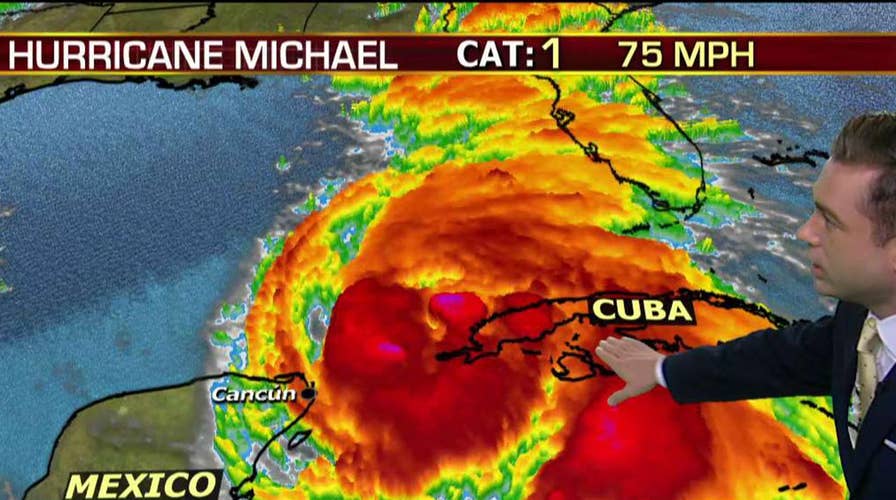Hurricane Michael expected to strengthen before landfall
National Hurricane Center warns Hurricane Michael could produce life-threatening conditions along the Gulf Coast; Adam Klotz reports from the Fox Extreme Weather Center.
A state of emergency was issued in Alabama on Monday as "dangerous" Hurricane Michael continues to barrel toward the U.S., with the potential to hit the Florida Panhandle mid-week.
The storm — which was upgraded to hurricane status earlier Monday — was roughly 485 miles south of Apalachicola, Florida, as of the National Hurricane Center's 8 p.m. ET advisory.
With maximum sustained winds of 85 mph while moving north at 12 mph, Michael is currently "bringing hurricane-force winds and heavy rainfall to western Cuba" as storm surge and hurricane warnings have been issued for the northeastern area of the Gulf Coast.
"There is a real possibility that Michael will strengthen to a major hurricane before landfall" after it spends the next two to three days over the Gulf of Mexico, which has very warm temperatures and favorable atmospheric conditions, Robbie Berg, a hurricane specialist with the NHC, wrote in an advisory.
HURRICANE MICHAEL'S PATH: TRACK THE STORM HERE
The Gulf Coast is forecast to see tropical storm conditions Tuesday night or early Wednesday, ahead of the hurricane activity expected for Wednesday.
Alabama Gov. Kay Ivey on Monday declared a state of emergency for the entire state as the storm pushes its way toward the southern U.S.
"Alabama is once again in the path of a hurricane, but I know Alabamians will once again come together and be prepared for whatever Michael may bring,” Ivey stated.
The governor noted that while state officials are prepared for the storm, she said "now is the time for residents in south Alabama to review your emergency preparedness plans and also get prepared" — warning that those in Michael's path "will need to take shelter by [Tuesday] evening."
Neighboring Florida Gov. Rick Scott issued a state of emergency on Sunday to 35 counties, and mandatory evacuations were ordered for residents of the state's barrier islands, mobile homes and low-lying coastal areas in Gulf, Wakulla and Bay counties.
He urged residents to quickly wrap up their final storm preparations Monday, calling Michael a "monstrous storm" with great destructive potential. He also waived tolls in a move to help coastal dwellers leave.
The state's Big Bend area, where the storm is expected to make landfall on Wednesday, could see up to 12 feet of storm surge, according to forecasters. Michael is also expected to hit the Panhandle that day, with the potential to dump up to a foot of rain in the area.
The U.S. military was moving its aircraft from the Panhandle on Monday. An Air Force spokesperson told Fox News that roughly 50 F-22 stealth fighter jets — valued around $150 million each — have been relocated from the Tyndall Air Force Base, while the U.S. Navy said it is moving all its training aircraft from Pensacola.
Fox News' Lucas Tomlinson and The Associated Press contributed to this report.



